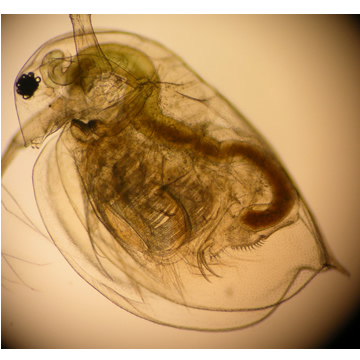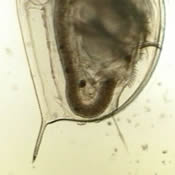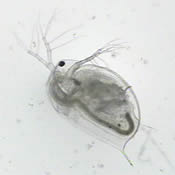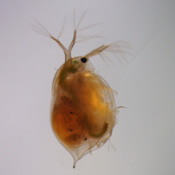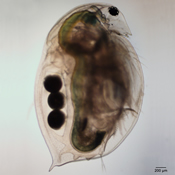| Ecology and Behavior | |||||||||||||||
| Characteristics | |||||||||||||||
|
|||||||||||||||
| Similar Species | |||||||||||||||
| Easily distinguished from other daphnid species by a carapace that extends into the head shield as a strip. | |||||||||||||||
| Geographic Distribution | |||||||||||||||
| Daphnia magna has a very limited and poorly known distribution in the Northeastern USA. D. magna does not appear to be widespread in the Northeast. It is occasionally found in small pools along the Atlantic Coast, because of its tolerance to relatively high salinity. D. magna occur regularly in a rock pool near Scutic Point, Maine, although surprisingly, it was not found in a survey of rock pools on the Isles of Shoals, Maine where D. pulex and Moina were the dominant cladocerans (pers.comm. Haney). | |||||||||||||||
| Reported Habitats | |||||||||||||||
|
|||||||||||||||
| Food and Feeding Behavior | |||||||||||||||
Movements of the thoracic appendages produce a constant current of water between the sides of the carapace (3). Small particles (<50 um in diameter) in the water are filtered out by fine setae on the thoracic legs and moved along a groove at the base of the legs to the mouth (3). All particles of suitable size are ingested without any selective mechanism (3). |
|||||||||||||||
| Predation on Daphnia | |||||||||||||||
Daphnia magna are vulnerable to fish predation due to their size and are lacking or severely reduced in lakes with fish (4). The large size of D. magna protects it from small invertebrate predators, although Chaoborous can prey on immature D. magna. D. magna are vulnerable to the predatory Heterocope septentrionalis, therefore do not exist in ponds inhabited by this copepod (8). |
|||||||||||||||
| Competition | |||||||||||||||
| At high food concentrations, D. magna can outcompete smaller cladocerans such as D. galeata and Bosmina spp. (5). When food concentrations begin to decline, D. magna shows a delay in reproduction, allowing smaller, more rapidly reproducing organisms to become dominant (5). D. magna can outcompete D. longispina at lower temperatures and higher food concentrations (6). | |||||||||||||||
| Migration | |||||||||||||||
| In the laboratory, D. magna show diel vertical migration in response to predation by fish (7). D. magna remain at lower layers of the water column during the day and move to the upper layer at night to avoid visually feeding fish (7). | |||||||||||||||
| Reproductive Habits | |||||||||||||||
| D. magna can reproduce asexually, without male fertilization. In both sexual and asexual reproduction, typically 6-10 eggs are released into the brood chamber (3). Eggs hatch in the brood chamber and are released approximately two days later when the female molts (3). | |||||||||||||||
| Additional Pictures | |||||||||||||||
|
|||||||||||||||
| References | |||||||||||||||
(1) HANSKI, I. , and E. RANTA. 1983. Coexistence in a Patchy Environment: Three Species of Daphnia in Rock Pools. J. Anim. Ecol. 52: 1263-279. (2) ARNER, M., and S. KOIVISTO. 1993. Effects of salinity on metabolism and life history characters of Daphnia magna. Hydrobiologia. 259: 69-77. (3) STIBOR, H., and D.M. NAVARRA. 2000. Constraints on the Plasticity of Daphnia magna Influenced by Fish-Kairomones. Funct. Ecol. 14: 455-459. (4) LAURIDSEN, T.L., and D.M. LODGE. 1996. Avoidance by Daphnia magna of Fish and Macrophytes: Chemical Cues and Predator-Mediated Use of Macrophyte Habitat. Limnol. Oceanogr. 41: 794-798. (5) TESSIER, A.J., L.L. HENRY, C.E. GOULDEN, and M.W. DURAND, 1983. Starvation in Daphnia: Energy Reserves and Reproductive Allocation. Limnol. Oceanogr. 28: 667-676 (6) BENGTSSON, J. 1986. Life Histories and Interspecific Competition Between Three Daphnia Species in Rockpools. J. Anim. Ecol. 55: 641-655. (7) DAWIDOWICZ, P., and C.J. LOOSE. 1992. Metabolic Costs During Predator-Induced Diel Vertical Migration of Daphnia. Limnol. Oceanogr. 37: 1589-1595. (8) HANEY, J.F., and C. BUCHANAN. 1987. Distribution and Biogeography on Daphnia in the Arctic . Mem. Ist. Ital. Idrobiol. 45: 77-105. |
|||||||||||||||
| Quicktime Movies | |||||||||||||||
|
